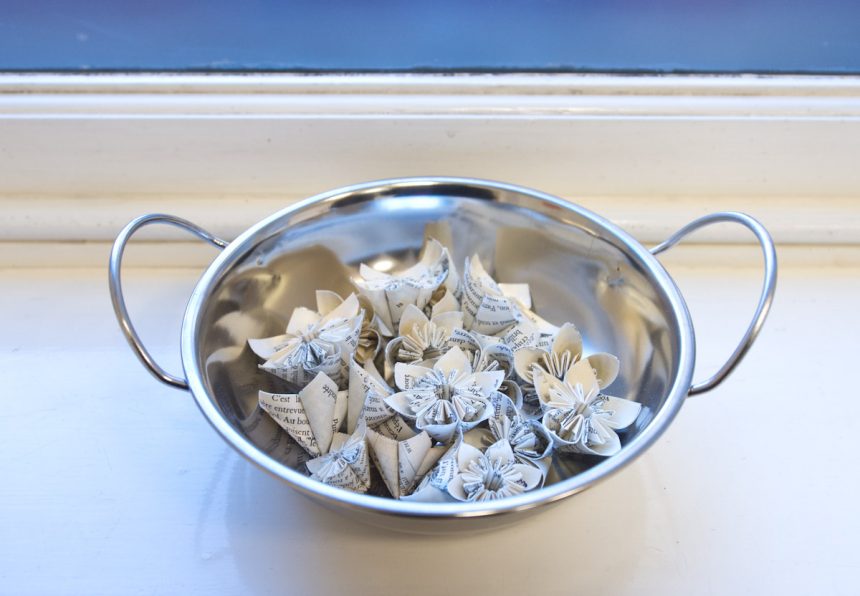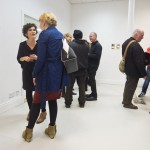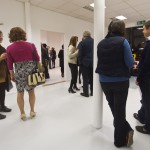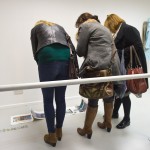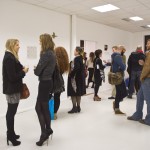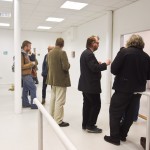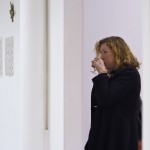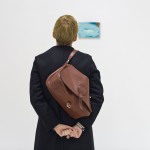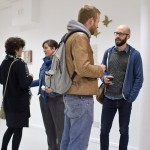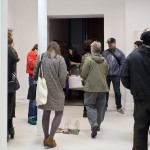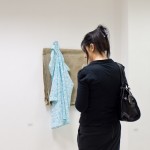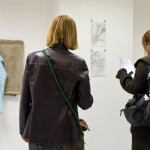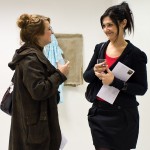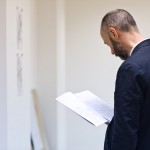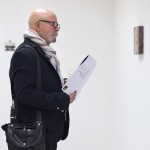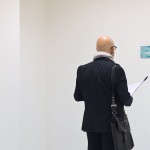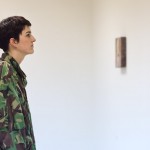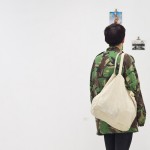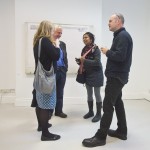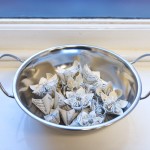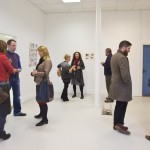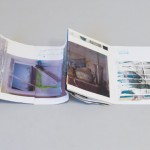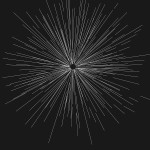Moments of Inception review
17 October – 16 November, 2013, QSS Studios and Gallery, Belfast
Review by Slavka Sverakova
See documentation of the exhibition
Expanding the curatorial field Eoin Dara has chosen the unexpected. Objects that may or may not be art, nonchalant debris of something else, birth of an idea made just about visible, or not. Dara describes his task:
I was also conscious of my privileged position as a guest in the studios, given free rein to roam about the building, ask questions of artists, and pore over finished artworks, works in progress, fledgling pieces and undeveloped studio experiments… I have chosen to focus on, and celebrate, the early artistic processes that take place in the studios, often seen by the artist’s eyes only… (QSS Gallery, Curatorial statement).
While I read Dara ‘s saying What we have here is a room full of beginnings, twenty beginning to be precise, each representing the denizens of the new studios at Bedford Street I remembered an essay about the end of art by A C Danto(1924-2013) namely this:
…the master narrative of the history of art–in the West but by the end not in the West alone–is that there is an era of imitation, followed by an era of ideology, followed by our post-historical era in which, with qualification, anything goes.
. . .In our narrative, at first only mimesis [imitation] was art, then several things were art but each tried to extinguish its competitors, and then, finally, it became apparent that there were no stylistic or philosophical constraints. There is no special way works of art have to be. And that is the present and, I should say, the final moment in the master narrative. It is the end of the story” (Arthur Coleman Danto, After the End of Art, Princeton University Press, 1997:47)
Danto closes his essay with a prediction about a world without aesthetic progress: “The institutions of the artworld — galleries, collectors, exhibitions, journalism — which are predicated upon history and hence marking what is new, will bit by bit wither away.”
If so, what happens to the artworld not predicated upon history? Danto insisted that “When one direction is as good as another direction, there is no concept of direction any longer to apply.” What this means is that direction is not a defining value. In fact, the poetic, charming expansion of exhibition of art in nascendi cannot rule out any direction and so the exhibition becomes one too. Focusing on the possible and not the necessary Dara converges on Danto’s preferred cheerfully eclectic approach, making the case for art’s various manifestations to the public rather than getting lost in internecine wars that were mainly of interest to the already initiated.
Jennifer Trouton’s constellation of wallpaper and maternal grandmother’s brass flying ducks assemble everyday objects in one of several possible constellations. This is different from a traditional assemblage because this arrangement is transitory, life like, work like.
Sinead McKeever shows two concertina notebooks made with collage of photographs, painting, vignettes stuck on vellum. Fragments and layers forge co-operation of being and not being without choking one another out of existence.
Dougal McKenzie states that he is interested in surfaces. This is how it is before he selects an idea and a composition. This arrangement of two types of textile is easily a metaphor for getting ready.
Catherine Davidson made these melodic swerving drawings of trees moving in the wind without her usual vivacious polychromy, in the shades of grey capturing a life force. Even the simple holders are a thoughtful choice.
Gail Ritchie has been involved in research of parallels between images of cut trees and fallen soldiers. The photo collage, postcard and a document from the Imperial War Museum, London, evoke somber remembrance of those who did not return to live.
Angela Hackett has been working in this variant of abstraction for some time now, here she is making a decision to abandon her usual palette, and still holding on to her “signature”. That is a risky move, glad to see that it feels strong. She offers a link :”this study in oil is an intuitive response to nature in winter…”
Majella Clancy, having finished her PhD degree is taking first steps to work in her luxurious new studio. It has a good light, an ingredient in this image employing paint, inkjet print, monotype and collage.
Gerry Devlin offers a twist on the idea of beginning. These photographs document everyday useful items . As finished images, however, they are commanded to become, in his words, “…carriers of social, historical and cultural significance”.
Christoff Gillen allowed a twin of his unfinished installation in a studio to descend onto the ground floor. Over an image of shirtless Vladimir Putin holding a gun, six empty milk bottle cradle used crayons. They are on the way to carry a political message, a characteristic of Gillen’s art.
Grace McMurray placed her work horizontally, on a pedestal, as if ready to sing a Gloria (preferably by Vivaldi). Satin ribbon woven in a honeycomb pattern glued to a fabric is an unusual way to draw.
I have appreciated the sensitive display in both gallery rooms, allowing me to contemplate one on its own or several objects together.
Zoe Murdoch made charming paper ‘flowers’ following a Japanese Origami technique called Kusudama. I lifted one, they appeared sturdy to touch while fragile to sight. She volunteered that the paper used are pages from Jean-Paul Sartre’s Les Jeux Sont Faits. And – that their future lies in Fenderesky’s exhibtion themed around Baudelaire’s Les Fleurs du Mal.
Clement McAleer has sent this abstraction to the world to announce either that it is a grounding for a future landscape or that it will stay as it is, keeping all its secrets. A welcome openness.
Ashley Holmes presents two contrasting way of making images. The drawing rejects to overwhelm the empty ground in quite a harmonious and generous manner. The object insists on layers of glazes that control the appearance and almost erase any marks of it being handmade.
Terry McAllister allowed an unfinished vista -taken from a clock tower, Dinan, Brittany- to let the viewer see how it is done. How the hand is so much slower that the vision. The fragment surrounded by empty ground is a telling evidence of the idea of invisible composition governing the work from the very beginning. His mastery of scale and tonality is, on the other hand, clearly visible.
Installation view includes work of three artists. From the left: Susan McKeever, David Turner and Gail Ritchie. David Turner made a memorial to his search for LEGO bricks all over the world. After he started making sculptures from Lego bricks, he found that many were difficult to obtain, hence piles of used envelopes and boxes from online retailers.
Another view of David Turner’s stack of used envelopes, then Colm Clarke’s loose assemblage and the already mentioned Dougal McKenzie’s piece. Colm Clarke stacked notes, drawings, schematic plans for his site specific installations and live work, over a “well used sheet”. It invites a privacy of deciphering and imagination.
Dorothy Hunter has considered constructivist concept of both drawing and sculpture, the sculptural element appearing ready for the world. Would it cut its umbilical cord with what appears as technical drawing?
Alacoque Davey cleverly contrasted earthly images of food, two pages from the Gardener’s Manual, 1934, with cutting edge abstraction, keeping a very light minimal touch. Mimesis cut with geometric abstraction – a revival of the dispute between Kandinsky and Mondrian.
Sally Young cadmium orange acrylic square recalls the heroic Albers or other abstract painters obsessed with that shape. Her choice of colour adds energy to those evoked memories. Exquisite case of ambiguity: it is confidently finished, and also it is a ground for more.
Susan McKeever explores incongruous sizes of marks in relation to the size of the ground while insisting on the ethereal hues and tonality to puzzle the eye as to the distances. Gestural abstraction always evokes the insecurity of distinction between the inner and outer.
The exhibition succeeded superbly to introduce each exhibit with its own “voice”, yet, to make them sing from one sheet: joy and discipline, insecurity and faith, play and commitment.


